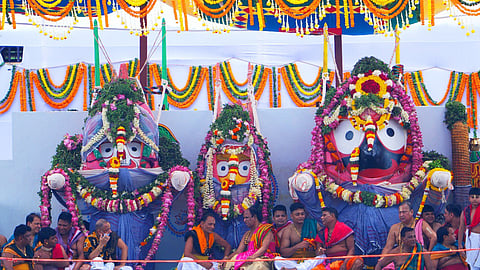
- LIFESTYLE
- FASHION
- FOOD
- ENTERTAINMENT
- EVENTS
- CULTURE
- VIDEOS
- WEB STORIES
- GALLERIES
- GADGETS
- CAR & BIKE
- SOCIETY
- TRAVEL
- NORTH EAST
- INDULGE CONNECT

As Odisha prepares for the grand spectacle of Rath Yatra, a quieter but deeply symbolic tradition unfolds behind closed temple doors in Puri. Known as Anavasara, which literally meaning “withdrawal from public view," this fortnight-long ritual sees the beloved Lord Jagannath and his siblings, Balabhadra and Subhadra, disappear from the Jagannath Temple.
It all begins on Snana Purnima, the full moon day of the Hindu month Jyeshtha, when the deities are bathed with 108 pots of holy, aromatic water in a spectacular public ceremony. This ritual cleansing, while spiritually significant, is believed to induce a divine fever.
As a result, the deities ‘fall ill’ and are moved into a private chamber Anasara Gruha where they remain for 15 days, away from the public gaze. During this time, temple priests and the Raja Vaidya (royal physician) administer a time-honoured treatment plan rooted in Ayurveda. Central to this regimen is a bitter medicinal decoction known as Dasa Mula Kadha. Prepared with a blend of ten sacred roots (dasa mula), tulsi, sandalwood, cardamom, black pepper, rose petals, and water from the Ganges, this herbal brew is said to boost immunity, reduce fever, and promote recovery.
The kadha isn’t just symbolic—it’s revered as a healing elixir. The deities are offered light food and chhena (cottage cheese), along with this potent tonic. Devotees too receive a small serving of the kadha as prasad, and many swear by its curative powers. Local legends even tell of miraculous recoveries attributed to a few sips of this sacred concoction—stories that keep the faith burning bright.
The Anavasara period concludes with Navajauban Darshan, when the deities reappear in a rejuvenated form, marking their symbolic ‘recovery’. They’re now ready to embark on their grand procession during Rath Yatra, radiating renewed strength and divine vitality.
For more updates, join/follow our WhatsApp, Telegram and YouTube channels.